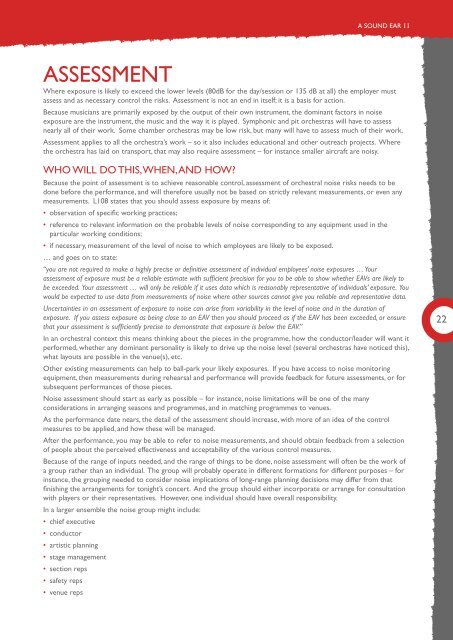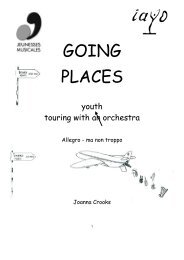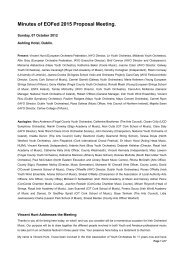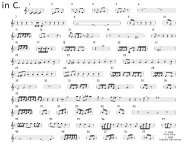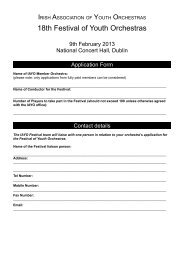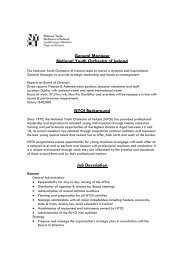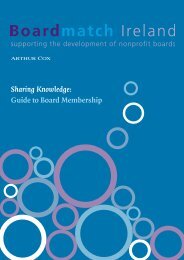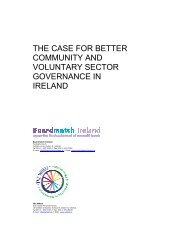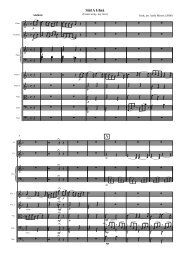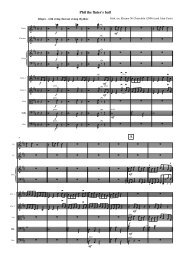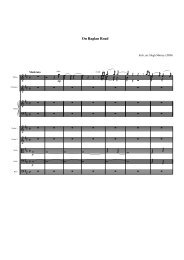A SOUND EAR II - Association of British Orchestras
A SOUND EAR II - Association of British Orchestras
A SOUND EAR II - Association of British Orchestras
You also want an ePaper? Increase the reach of your titles
YUMPU automatically turns print PDFs into web optimized ePapers that Google loves.
A <strong>SOUND</strong> <strong>EAR</strong> <strong>II</strong><br />
Assessment<br />
Where exposure is likely to exceed the lower levels (80dB for the day/session or 135 dB at all) the employer must<br />
assess and as necessary control the risks. Assessment is not an end in itself; it is a basis for action.<br />
Because musicians are primarily exposed by the output <strong>of</strong> their own instrument, the dominant factors in noise<br />
exposure are the instrument, the music and the way it is played. Symphonic and pit orchestras will have to assess<br />
nearly all <strong>of</strong> their work. Some chamber orchestras may be low risk, but many will have to assess much <strong>of</strong> their work.<br />
Assessment applies to all the orchestra’s work – so it also includes educational and other outreach projects. Where<br />
the orchestra has laid on transport, that may also require assessment – for instance smaller aircraft are noisy.<br />
Who will do this, when, and how?<br />
Because the point <strong>of</strong> assessment is to achieve reasonable control, assessment <strong>of</strong> orchestral noise risks needs to be<br />
done before the performance, and will therefore usually not be based on strictly relevant measurements, or even any<br />
measurements. L108 states that you should assess exposure by means <strong>of</strong>:<br />
• observation <strong>of</strong> specific working practices;<br />
• reference to relevant information on the probable levels <strong>of</strong> noise corresponding to any equipment used in the<br />
particular working conditions;<br />
• if necessary, measurement <strong>of</strong> the level <strong>of</strong> noise to which employees are likely to be exposed.<br />
… and goes on to state:<br />
“you are not required to make a highly precise or definitive assessment <strong>of</strong> individual employees’ noise exposures … Your<br />
assessment <strong>of</strong> exposure must be a reliable estimate with sufficient precision for you to be able to show whether EAVs are likely to<br />
be exceeded. Your assessment … will only be reliable if it uses data which is reasonably representative <strong>of</strong> individuals’ exposure. You<br />
would be expected to use data from measurements <strong>of</strong> noise where other sources cannot give you reliable and representative data.<br />
Uncertainties in an assessment <strong>of</strong> exposure to noise can arise from variability in the level <strong>of</strong> noise and in the duration <strong>of</strong><br />
exposure. If you assess exposure as being close to an EAV then you should proceed as if the EAV has been exceeded, or ensure<br />
that your assessment is sufficiently precise to demonstrate that exposure is below the EAV.”<br />
In an orchestral context this means thinking about the pieces in the programme, how the conductor/leader will want it<br />
performed, whether any dominant personality is likely to drive up the noise level (several orchestras have noticed this),<br />
what layouts are possible in the venue(s), etc.<br />
Other existing measurements can help to ball-park your likely exposures. If you have access to noise monitoring<br />
equipment, then measurements during rehearsal and performance will provide feedback for future assessments, or for<br />
subsequent performances <strong>of</strong> those pieces.<br />
Noise assessment should start as early as possible – for instance, noise limitations will be one <strong>of</strong> the many<br />
considerations in arranging seasons and programmes, and in matching programmes to venues.<br />
As the performance date nears, the detail <strong>of</strong> the assessment should increase, with more <strong>of</strong> an idea <strong>of</strong> the control<br />
measures to be applied, and how these will be managed.<br />
After the performance, you may be able to refer to noise measurements, and should obtain feedback from a selection<br />
<strong>of</strong> people about the perceived effectiveness and acceptability <strong>of</strong> the various control measures.<br />
Because <strong>of</strong> the range <strong>of</strong> inputs needed, and the range <strong>of</strong> things to be done, noise assessment will <strong>of</strong>ten be the work <strong>of</strong><br />
a group rather than an individual. The group will probably operate in different formations for different purposes – for<br />
instance, the grouping needed to consider noise implications <strong>of</strong> long-range planning decisions may differ from that<br />
finishing the arrangements for tonight’s concert. And the group should either incorporate or arrange for consultation<br />
with players or their representatives. However, one individual should have overall responsibility.<br />
In a larger ensemble the noise group might include:<br />
• chief executive<br />
• conductor<br />
• artistic planning<br />
• stage management<br />
• section reps<br />
• safety reps<br />
• venue reps<br />
22


